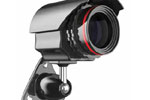
Exploring the Surveillance Frontier
Superior images and efficiency are driving megapixel video into the mainstream
- By Scott Schafer
- Sep 01, 2011
Numerous factors are accelerating the video
surveillance industry’s transition to IP-based
systems, including ease of integration, flexibility
to interface with other systems and the ability
to make video accessible on the enterprise level. One
of the greatest influences driving the transition to IP
systems is the superior image resolution of megapixel
IP-based cameras, which also can boost overall system
functionality while lowering costs. To get a better
grasp on this trend, let’s take a closer look at the advantages
megapixel technology has to offer.
Image quality improvement is stunning, and needed.
For an industry used to making do with the quality
of analog video images, the bigger, clearer, more-detailed
images IP megapixel video cameras provide can
be a real eye-opener. Megapixel video represents a
new frontier in video surveillance technology, providing
new and exciting applications. Old assumptions
about how video performs in various situations can
be thrown out the window. Now there are megapixel
solutions with the resolution—whether 1.3, 5, 10
megapixels or more—to handle virtually any application.
This is critical, because today’s systems can now
be designed to fit the application instead of being restricted
by the limitations of the old NTSC standard.
Fewer cameras are necessary. Megapixel imaging
makes it possible for a single camera to take the
place of three, 10 or even more analog or standardresolution
network cameras. Megapixel cameras can
view much larger areas without missing any details.
One megapixel camera can view an entire parking lot,
for example, taking the place of several PTZ cameras.
It can also continuously capture all activities in the
viewing area while an operator electronically zooms
in on a specific area of interest, which is simply not
possible with conventional cameras. As a result,
megapixel cameras allow you to deploy fewer cameras
while actually improving coverage. Fewer cameras
also translates into lower costs relative to the initial
purchase of cameras and related equipment, as well
as less infrastructure overall. The ability to zoom in
on recorded images allows customers to opt out of
hiring people to monitor video, saving labor costs.
The cost savings can be substantial, are measurable
and provide a strong return on investment for megapixel
systems.
Customers expect more and better image quality.
Viewers’ expectations for image quality are higher
than ever. The proliferation of HD content in people’s
homes, on their mobile devices and on their desktops
means that most people have a higher expectation of
what looks good. With megapixel cameras, security
professionals can cost-effectively deploy video surveillance
systems that deliver great detail—not because
they look great, but rather because these detailed images
best serve the applications enterprises desire. The
primary objective of most video surveillance systems
is to provide better security, and nothing matches the
detail and forensic capabilities that megapixel cameras
provide.
Storage and bandwidth issues are a thing of the past.
Obviously, storage and network bandwidth are important
considerations when designing any IP-based
video system, but the issues that plagued early systems
have been resolved. New cameras and network
video recorders have embraced the H.264 video compression
standard, which minimizes the storage and
bandwidth needs of high-resolution images. Megapixel
cameras can be programmed to switch resolution
levels based on user-defined criteria. This ability
to change resolution also greatly reduces bandwidth
usage across the system.
Megapixel cameras provide a systemwide solution.
Megapixel video cameras have become a mainstream
imaging solution due to numerous advances and are
no longer relegated to specific niche applications
within a system. They work best anywhere you need
camera coverage. Today, major commercial firms and
government agencies are deploying megapixel cameras
on a systemwide basis. Many of these installations
deploy hundreds, sometimes thousands, of megapixel
cameras. Megapixel cameras have achieved mainstream
status for good reasons.
Megapixel cameras are available for any application.
Megapixel cameras are available in a wide range
of sizes and configurations. There are all-in-one
megapixel dome cameras, outdoor bullet cameras,
compact cameras, dual-sensor day/night cameras and
multi-megapixel panoramic view cameras. Megapixel
cameras can be vandal-resistant, employ infrared illuminators,
and feature a variety of environmental
housings and range of resolutions to meet the needs
of any application. Image quality is paramount, but
frame rates and compression efficiency (using H.264)
also are key considerations.
Simplified installation and maintenance. Megapixel
IP video systems are configured using the same “building
blocks” as IT systems, including servers, network
switches, digital storage and workstations. This allows
megapixel cameras to integrate with other video
surveillance and security devices with cost-efficiency.
Using IP network infrastructure minimizes the need
to run separate cables from every camera to every recorder,
and the need for fewer cameras creates further
efficiencies. Structured cable—Cat-5 or Cat-6—is less
expensive than coaxial cable. It weighs less, is far less
bulky and has a faster transmission speed. Cabling is
also simplified with PoE, where power is supplied to
cameras over the same cable as video and data signals,
thus eliminating the need for a separate power source
to the camera. The overall system and economic benefits
of megapixel cameras are significantly stronger
than those of conventional IP and analog cameras.
Education is vital. Education on the overall performance
and ROI advantages of megapixel imaging solutions
is key to the continued growth and acceptance
of megapixel technology for mainstream applications.
In challenging economic times, end users face an unprecedented
need to justify expenditures. In this business
climate, it’s critical to show that new systems are
cost-efficient and perform at a superior level to the
systems they are replacing. Decision-makers can literally
see the benefits of a clearer megapixel image and
appreciate the cost advantages of using fewer cameras,
less infrastructure and simpler installation. And
the security industry will benefit with a new, more effective
tool to fulfill its mission.
This article originally appeared in the September 2011 issue of Security Today.